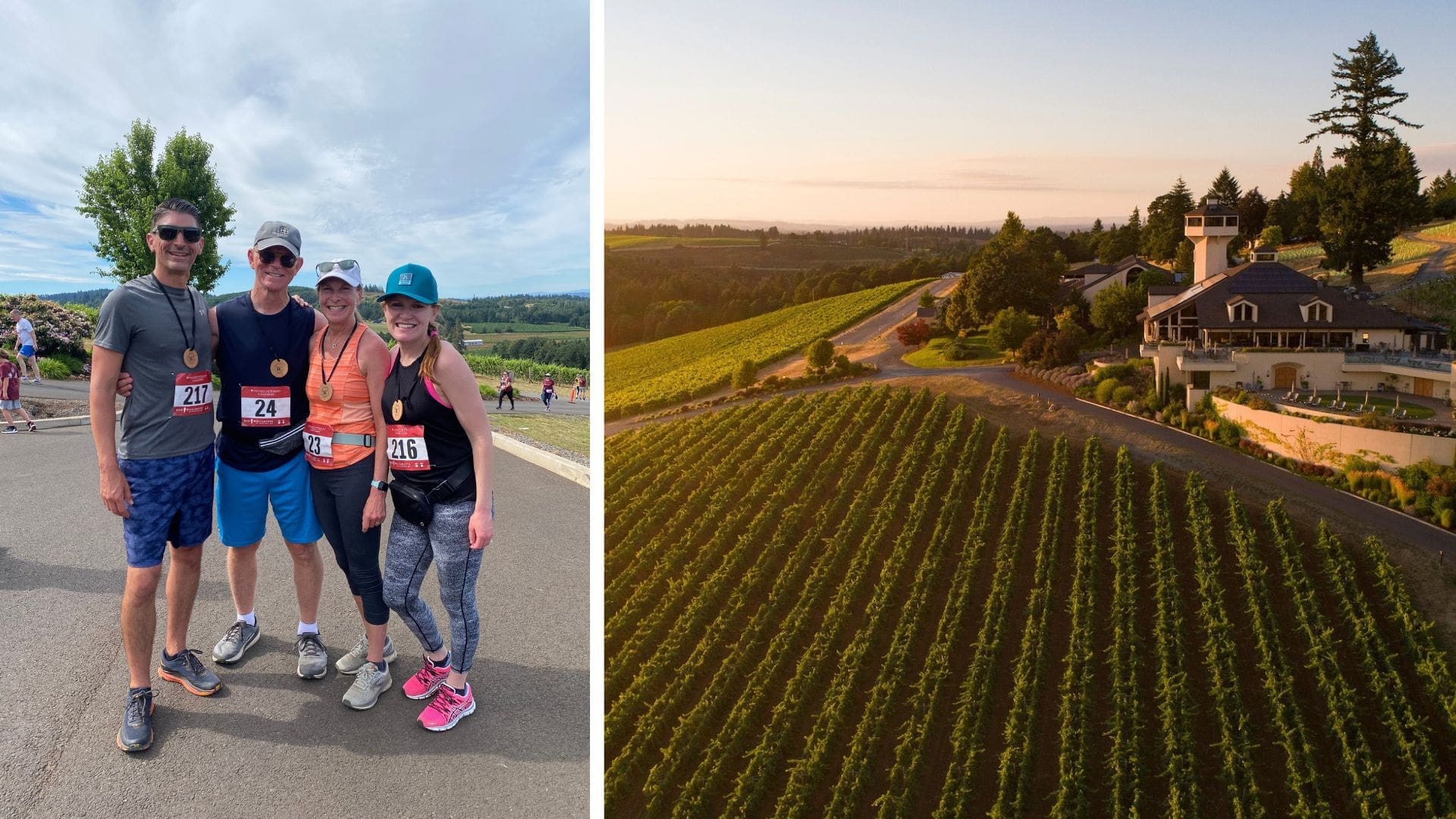Compromised of 18 specific wine grape growing regions, the state of Oregon has diverse climates and locations perfect for growing more than 72 wine grape varietals. Each viticultural area is specific to its geographic location, soil type, climate and topography. In honor of Oregon Wine Month, here is the second installment of getting to know your Oregon AVAs. Missed the Chapter One? Read about the first nine here. Facts provided by the Oregon Wine Board.
Ribbon Ridge
Contained within the larger Chehalem Mountains AVA, Ribbon Ridge is located 22 miles southwest of Portland and is approximately 3.5 miles long and 1.75 miles wide. In 1980, Chehalem Winery’s Harry Peterson-Nedry planted the first wine grapes at his Ridgecrest Vineyards. A few decades later and the Ribbon Ridge received its official AVA status in 2005. The region’s grape growing hillsides are warmer and slightly drier compared to the adjacent climates. This climate provides early grape growth in the spring, even ripening throughout the summer and a full-fledged season in the fall. Sitting 683 feet from the Chehalem Valley floor, Ribbon Ridge contains younger and finer sedimentary soils compared to the neighboring regions.
The Rocks District of Milton-Freewater
This small, 5.9-square-mile region is contained within the greater Walla Walla Valley and Columbia Valley AVAs. The Rocks District derived its name from the exceptionally rocky soils that surround the vines. The soils consist of pebbles and cobbles of basalt in a matrix of sand and silt that is well-drained, encouraging deeply rooted vines with strong heat transfer. Italian emigrants established grape growing in The Rocks District when they first arrived to Oregon in the 1860s and just 20 years later, the area was producing thousands of gallons of wine for miners in northern Idaho. Cold winters struck the area by the end of the 1880s, forcing many farmers to convert their land to orchards. Fast-forward to 2015 and The Rocks District of Milton-Freewater officially became approved as Oregon’s 18th AVA.
Rogue Valley
Oregon’s southernmost region is the Rouge Valley AVA. Extending from the foothills of the Siskiyou Mountains, this valley is surrounded by the Bear Creek, Applegate and Illinois Valleys. The 70-by-60-mile region dates back to the 1840s with European immigrants starting planting and bottling grapes. The appellation became official in 2001. Due to the diverse climates surrounding Rogue Valley, its mix of metamorphic, sedimentary and volcanic derived soils allows for growing of both cool- and warm-climate grape varietals. Vineyards often sit around 1,200 to 2,000 feet and are planted on hillsides rather than the valley floors.
Snake River Valley
Spanning from northeastern Oregon to southwestern Idaho, the Snake River Valley AVA has a total area of 8,000 square miles and two states. Although the Oregon region is limited with vineyards and wineries, the region reaching Idaho is home to the largest density of wineries in the state. Geographically, the AVA is ideal for grape growing and provides a distinct four-season climate. The freezing winters allow vines to grow dormant, keeping bugs and disease astray. Plus the region has minimal rainfall during the year, making it easier for farmers to keep mold and rot away from the vines. Lack of rainfall can simply be fixed with a controlled and timed irrigation system. Soils are compromised of ancient volcanic sediment that has bestowed fertile, well-draining soils, giving farmers better control throughout the process. The region has high elevations ranging from 2,500 to 3,000 feet above sea level with more than 400 miles between the valley and the Pacific Ocean.
Southern Oregon
Stretching 125 miles south of Eugene to the California border, Southern Oregon AVA encompasses the Applegate Valley, Elkton Oregon, Red Hill Douglas County, Rogue Valley and Umpqua Valley appellations. The appellation became official in 2004. Today the region is producing some of Oregon’s most high-quality wines. Although the region produces mostly warm-climate varietals, there are cool micro-climates hidden within the hillsides and valleys. Southern Oregon sees around 40 percent less rainfall than the Willamette Valley AVA and has generally sunny seasons. The region’s soils are derived from the 200-million-year-old Klamath Mountains bedrock, which are mainly compromised of sedimentary rocks. Vineyards in Southern Oregon often sit on 1,000 to 2,000 feet with mountainous ranges surrounding the area.
Umpqua Valley
With the Coast Range to the west and the Cascade Range to the east, unique terrain and complex topography surround this AVA. German immigrants who had worked for the Beringer Bros. planted the first wine grape vineyard in the valley during the 1880s. Post-prohibition winemaking started in early 1961 when Richard Sommer moved north from the University of California at Davis, founding Hillcrest Vineyards. Other winemakers followed his lead and began planting cool- and warm-climate grapes in the 1970s. The appellation became official in 1984 and is still evolving today with new winemakers popping up in the region each year. The region’s soils are as diverse as the climate with a mix of metamorphic, sedimentary and volcanic rock. More than 150 soil types have been identified in the Umpqua Valley, allowing for a vast selection of wines to come out of the region. Also know as “The Hundred Valleys of the Umpqua,” this AVA is more so a series of small mountain ranges and valleys.
Walla Walla Valley
The Walla Walla AVA lies between northeast Oregon and southeast Washington with more than 2,000 acres of vineyards located within the Blue Mountains, the Palouse and the Columbia River. Its wine growing history dates back to the 1920s with modern day industry starting in the 1970s. The appellation officially began in 1984 but it took another decade for growth to kick-off. Once early 2000 hit, Walla Walla had more than 50 wineries and today the region has more than 100 calling it home. The climate in Walla Walla is ideal for grape growing with dry summers and cool fall nights assuring acidity for top-flight wines. The soils located in the AVA are loess (wind-deposited silt) overlying flood sediments, thick loess overlying basalt bedrock, basalt cobblestone gravels and very thin loess on basalt bedrock. Elevations in the Walla Walla Valley have a vast range from 400 feet to 2,000 feet above sea level.
Willamette Valley
Running from the Columbia River in Portland all the way through Salem and to the Calapooya Mountains south of Eugene, the Willamette Valley is more than 150 miles long and 60 miles wide. It is home to the largest concentration of wineries and vineyards in Oregon with six appellations in its boarders: Chehalem Mountains, Dundee Hills, Eola-Amity Hills, McMinnville, Ribbon Ridge and Yamhill-Carlton. Between 1965 and 1968, David Lett, Charles Coury and Dick Erath slowly migrated north to the Willamette Valley, despite friends and family telling them it was impossible to grow grapes in Oregon. Years later, they proved them wrong with the Willamette Valley being recognized as one of the world’s premier wine producing regions. The appellation became official in 1983. The Willamette Valley is relatively mild throughout the year with wet winters and warm summers. Soils are mostly old volcanic and sedimentary seabed that has been overlaid with gravel, silt, rock and boulders.
Yamhill-Carlton
Contained within the Willamette Valley AVA, Yamhill-Carlton is located 35 miles southwest of Portland encompassed by both towns of Yamhill and Carlton. The region has a relatively new wine history as it was once primarily known for livestock, tree-fruit orchards and wheat fields. In 1974, Elk Cove Vineyards began producing the first commercial wine in Yamhill-Carlton with pioneers Pat and Joe Campbell as founders. The appellation was officially established in 2005. Protected by highly elevated areas surrounding, Yamhill-Carlton has moderate growing conditions well suited for cool-climate grapes and signature Pinot Noir. The region’s soils are comprised of coarse-grained, ancient marine sedimentary soils over sandstone and siltstone that all drain quickly, making them ideal for viticulture. These soils result in wines with lower acidity. Vineyards often sit between elevations of 200 and 1,000 feet in Yamhill-Carlton, avoiding valley frost during the cooler seasons.










